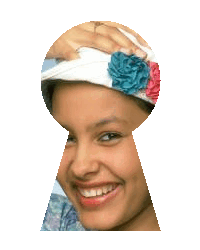class RVG::ClipPath < Object
Table of Contents
class methods
attributes
instance methods
shared methods
In addition to the methods listed above,
class RVG::ClipPath also implements the styles method and the shape methods.
class methods
new
RVG::ClipPath.new(clip_path_units) [ { |clippath| drawing method calls } ] ->
clippath
Description
Creates a clipping path. A clipping path is a combination of path, text, and basic shape objects that define an outline. Attach the clipping
path to an object such as a raster image or RVG object with the :clip_path style. When RVG draws the object, things "outside" the path are not drawn.
The ClipPath.new method yields to a block. Within the block define the clipping path with a combination of path, basic shape, and
text objects. You can also use the use method to refer to a previously-defined object or group of objects.
Arguments
- clip_path_units
-
Defines the coordinate system for the contents of the clipping path. This argument can take either of two values,
userSpaceOnUse, or objectBoundingBox. If
userSpaceOnUse, the contents of the clipping path represent
values in the current user coordinate system in place at the time when the clipping path is referenced. if objectBoundingBox, then the user coordinate
system for the contents of the clipping path is established using the bounding box of the object to which the clipping path is applied. The default is
userSpaceOnUse.
Example

See Also
The :clip_rule style.
attributes
desc, desc=
clippath.desc -> string
clippath.desc = string
Description
Use the desc attribute to assign a text description to the clipping path.
clippath.metadata -> string
clippath.metadata =
string
Description
Use the metadata attribute to assign additional metadata to the clipping path.
title, title=
clippath.title -> string
clippath.title =
string
Description
Use the title attribute to assign a title to the clipping path.
instance methods
text
clippath.text(x=0, y=0, text=nil) [{|text| ...}] -> text
Description
Calls RVG::Text.new to construct a text object and adds it to the clipping path. Yields to a block if one is present,
passing the new text object as an argument.
Returns
The RVG::Text object, so other RVG::Text methods can be chained to this method.
use
clippath.use(obj, x=0, y=0,
width=nil, height=nil) -> use
Description
Calls RVG::Use.new to constructs a use object and adds it to the clipping path.
When the referenced argument is another RVG object,
width and height can be used to specify the width and height of the viewport. If present and non-nil,
these arguments override any width and height specified when the RVG object was created. You must specify the viewport size either when creating the RVG
object or when referencing it with use.
Examples
See RVG::Use.new
Returns
The RVG::Use object, so other RVG::Use methods can be chained to this method.
